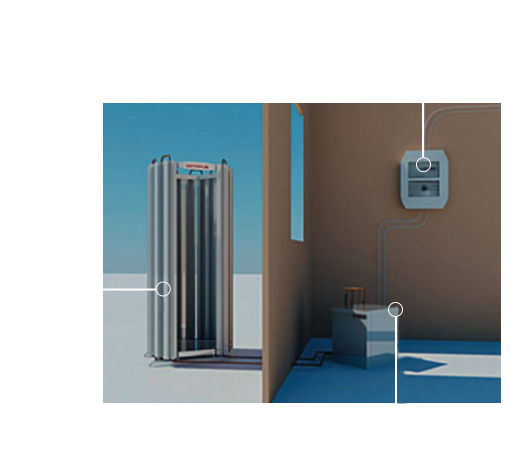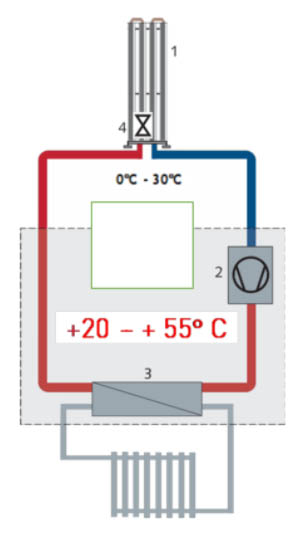Octopus heat pump - How it works
Parts of the system
Part of the equipment is a control panel (Octopus 1), indoor heat pump module (2) and the evaporator, so called Ice Stick (3).
Depending on the configuration the number of the outdoor and Ice Stick units of the heat pump system can vary. The heat pump is a device that gathers energy from the outdoor low temperature environment and transmits it to the heating system via a heat transfer medium.
The control panel manages the operation of the heat pump and the additional heating system of the house.
Operation
The outdoor module is connected with the indoor module of the heat pump with the two copper pipes where the refrigerant R290 (C3H8 propane) is circulating in the form of gas or fluid. From outdoor to indoor modules, propane converts to fluid through a capillary pipe under the pressure and favourable temperature.
In the outdoor module freon transmits through the special valve after it the freon pressure falls down and it evaporates cooling till the temperature -42,6 °C. The outdoor module works as a large surface heat exchanger; it cools to the temperature lower than the outdoor temperature due to the propane transmitting in it. Thus, due to the difference in temperature in the air and the outdoor module, and due to the convection of the air and winds, the outdoor module heats and transmits gathered energy to gas.
Then gas transmits to the indoor module of the compressor. It compresses the gas till it is overheated and (in the next stage) transmits its energy via the heat exchanger to the heat transfer medium of the heating system.
During the energy transfer, the gas becomes condensed i.e., turns to fluid, and the circle of heat pump operation is closed. So, water is heated under a continuous cycle. Due to measuring devices installed by the manufacturer, the system detects when the outdoor module should be turned off; it does it automatically.
Heat pump operation – in 4 steps
1. The heat gathering part - lower pressure. This part of the heat pump is called evaporator (1). The low temperature refrigerant flows through the Ice Stick under pressure and cools down. The evaporator gathers energy due to heat transmitting (air temperature is higher than the temperature of the refrigerant), and air humidity condensates on the surface of the evaporator.
2. The pressure rising part - higher pressure. This part consists of a compressor (2). The temperature of condensation and the temperature of the refrigerant increases under the compression of the refrigerant.
3. The heat emitting part - high pressure. The refrigerant passes through the heat exchanger (condenser) and the condensation phase (3) at a high temperature, where it transmits energy that is released by the condensation of the refrigerant to the water.
4. Pressure lowering part - low pressure. The condensed refrigerant directs through the expanding valve where pressure and temperature are decreased to the level at the beginning of the process.

